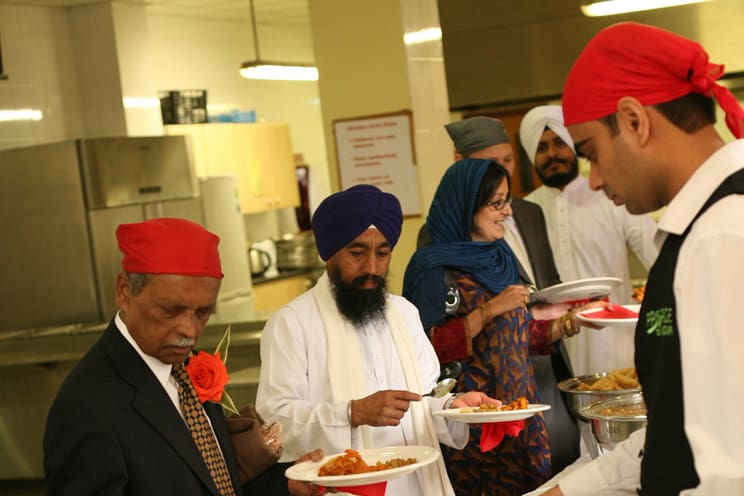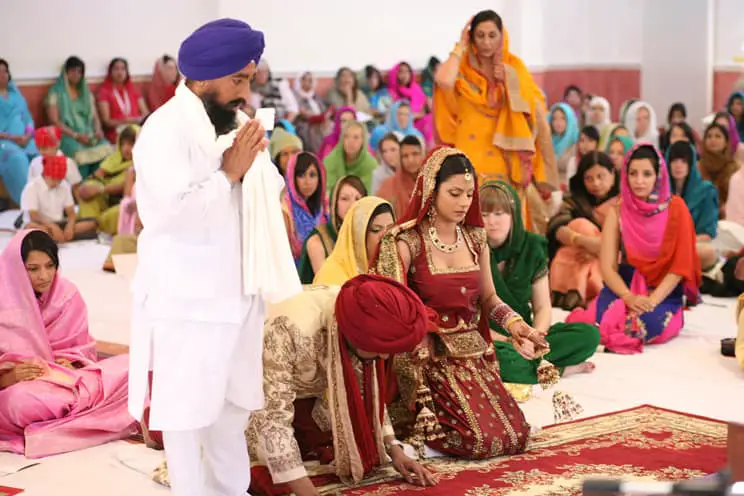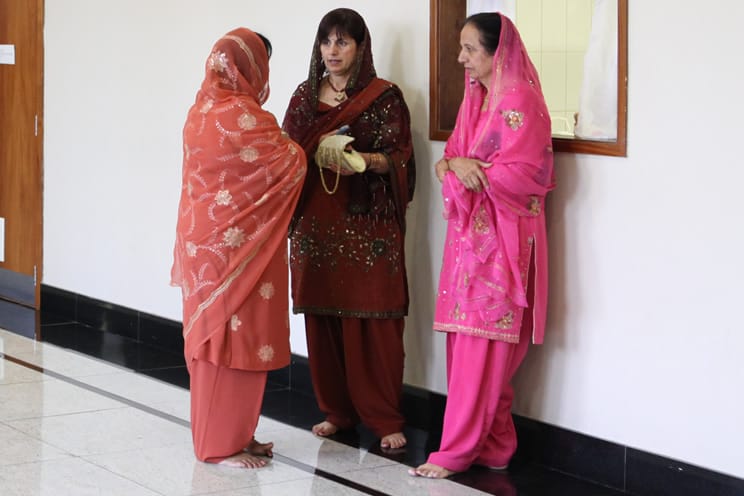
When I got an invitation to attend a Sikh wedding, I assumed many of the requirements I was told would fall into place one by one without much effort from me. I had participated in many other weddings before this, so what’s the big deal?
Is it necessary to learn how to cover your head for a Sikh wedding? Yes, covering your head is necessary for a Sikh wedding and vital. Chances are, you will not always be having someone close by to help you cover your head. You don’t have to ask for help each time you get an invitation to a Sikh wedding. If you take the time to learn, it is an investment because the knowledge is yours permanently. It also goes to show how much you are interested in and care about the Anand Karaj or wedding.
As I rudely realized, A Sikh wedding is not like any other wedding. It is unique. You need to kickstart the preparing the moment you receive an invitation, especially if it is going to be your first Sikh wedding.
There is much to learn and unlearn along the way, but the best news is that it was the most lively and interesting wedding I ever attended.
It is more than the bride and the groom exchanging vows. You become part of it; you feel you have a stake in the wedding and the marriage that it births. That’s how I felt. It took long, as all Sikh weddings do, but, surprisingly, I didn’t realize it.
A Sikh wedding is elaborate, so if you are to attend one, you need to take the time to understand the minute details of the requirements and learn to perform them. Learning how to cover your head for a Sikh wedding is one of the nitty-gritty that you cannot afford to overlook.
At the wedding, every guest or typical Sikh has to follow the Sikh dress code. There is no compromise on that, so if you are to attend a Sikh wedding, you must dress appropriately or simply fail to attend.
The Sikhs are very friendly folks, to be sure, but they are not in the habit of relaxing their rules to accommodate anyone who turns up at their temple. Well, it is not like you are doing them a favor for coming. They feel you stand to benefit more by coming to their gathering, so the little they require is that you respect their customs for the duration you are going to be with them.
Why Do Sikhs Cover The Head?
To appreciate the value of covering the head, it is essential to understand its noble significance for Sikhs. Indeed, you can only learn to respect a culture if you at least understand the reasoning behind its significant customs.
The Sikhs do not practice traditions for the sake of them but have good reasons behind them. The Sikhs keep their hair in its natural state without alteration. Why? It enables them to focus on the more important matters of life: serving humanity and worshipping God.
You have seen how the Western culture of hair care costs much time, care, energy, and money in many third-world societies. People who cannot afford enough to eat still spend the little they have on hair care. It would be better if the hair were covered, but then, that’s my personal observation.
The hair maintained in this condition is known as kesh. For your hair to be kesh, an initiation has to be carried out where Khalsa is sprinkled on your hair to make it sacred.
The children are also to keep their hair natural from birth. To keep the hair from tangling or coming into contact with spiritually unclean stuff such as tobacco smoke, they wear headcovers.
A headcover also takes the attention away from the hair to more critical aspects of life, such as honoring God.
However, this doesn’t mean you are supposed to neglect your hair care because, after all, it is hidden under a headcover.
A Sikh has to clean his hair and comb his beard on a daily basis before tying a headcover.
Types of Sikh Head Covers and How to Use Them
There are many Sikh headcovers to choose from, depending on your role in the wedding.
1. Sehra Head Cover
Sehra was initially designed and meant to protect the groom from evil people who could cast a spell on him at a wedding ceremony for the marriage to fail.
Sehra is the Sikh head cover the groom wears at the wedding. They are especially common in North India. It not only covers the head but also has a garland veil to cover the groom’s face. Sehra is well-decorated and can be made from beads or flowers. The groom ties it on his Pagri or turban.
Nowadays, many Sehras come already stitched on to the Pagri for convenience. They have also changed in size, shape, and dimensions. While some Indians no longer see the value of wearing a Sehra, it is still popular with the Sikh community who are keen to preserve their identity.
The Sikhs use fresh flowers and beads to make the Sehra veil. It means it is best prepared on the wedding day because if it is completed earlier, the wilting flowers will not give the groom the desired splendor.
However, the latest innovations have made it possible to make Sehra using plastic flowers. The advantage of this is that you can customize it to rhyme with the wedding theme color or outfit.
You can choose a Sehra with one color or go for one with different colors. You can also add ornaments to your Sehra. The typical additions to it, include a peacock, feathers, pearls, etc.
A Sehra also enhances the groom’s splendor and adds an element of mystery because his face is partially hidden, just as the bride’s.
2. Pashmina
Pashmina is one of the most popular Sikh dress. Pashminas come in various colors and can be worn in different ways to serve other purposes. Unlike the regular scarf, pashmina is relatively lighter but can still keep you from catching a cold if you wrap it around your shoulders.
You can also turn it into a headcover. On a windy day, wearing a pashmina tightly o your head is going to keep your hair in place.
To wear your pashmina as a headscarf, throw it over your head and push then push the right hanging end over your left shoulder. Likewise, push the left end over your right shoulder.
Once this is done, ensure both sides are balanced so that no side is raised above the other. You then pin the pashmina at the right points to keep it in place. Without pinning, it may roll down and leave your head exposed, which is not acceptable in a Sikh temple.
A bride or bridesmaid can use a pashmina as part of her wedding day gown. It is draped over the shoulders and then used to cover the head if need be.
3. Pagri (Turban)
A turban is one distinct Sikh identity that physically defines them. It is the most popular head cover among the Sikh community. Sikh soldiers used a turban to hold their long hair out of their eyes, and also to protect their heads from bullets, swords, arrows, and other missiles.

It gradually became a symbol of respect for men and is worn mainly by the Sikh men, not women. A stylish woman can choose to wear a scarf over a turban.
Kings and queens wore turbans to signify their royal status. The Sikhs adopted the turban to show that every human being is equal and royal before God.
Many Indian communities may wear turbans for cultural purposes, but for a Sikh, it is not just a culture passed down from generation to generation, but a representation of commitment. When a Sikh chooses to go around in a turban, it is a manifestation that he is willing to publicly state that he is a Sikh, be he in India, Iraq, the USA, UK, Africa, or Russia.
It means he doesn’t care what others will think about him, as long as he is true to his faith. A true Sikh should not be afraid to stand out even among strangers. Wearing a turban is one way to stand out among the over seven billion people on earth.
The Sikhs have a distinct method of wearing a turban that is different from the, say, Arab cultures whose turbans have a back tail hanging.
Every Sikh male is under obligation to wear a pagri or turban when in front of Guru Granth Sahib. A staunch Sikh male wears the turban every morning and only removes it when washing the hair.
In that case, he folds it carefully and ensures it never comes into contact with the spiritually unclean stuff on the floor.
A wedding ceremony inside the Gurdwara is one place a pagri should be worn. Turbans come in different styles, fabrics, colors, and shapes depending on the occasion, taste, status, or religious conviction.
For a formal gathering, many Sikhs go for the longer turbans. The color will be decided based on the occasion, but black, white, blue, and orange are mostly reserved for religious functions.
For a Sikh wedding, you should consider a red turban. It stands out. A Sikh wedding is supposed to be lively, so dull colors are not common. At the reception after the wedding, you can change into a patterned turban.
In a Sikh wedding worth the name, the groom enters riding a horse, and he is dressed like a king. A Punjabi turban decorated with jewels is one of the clothes that make up his attire.
Note that different sects of Sikhism use different turbans. How they are tied may also differ. There are cases where turban styles are different from village to village or community to another.
Therefore, while there is a standard formula for wearing a turban, you may have to do slight alterations to accommodate the style of the locality you are in.
How to Cover Your Head with a Turban for a Sikh Wedding
To follow the Sikh traditions of tying a turban, you should use a wooden comb known as kanga to untangle your hair. You should then apply oil to the hair though this is not mandatory.
After that, you twist your hair into a bun that coils on top of your head. The bun or knot is known as a joora, and you can use a piece of cloth to bind it. The piece of cloth used is called Keski.
Ensure you do not make the joora up on your head top or forehead but towards the back of your head. If the joora is right up on your head, the turban will have to be high up.
- Fold the keski uniformly, maintaining the length of 0.5 – 2 feet.
- Stretch the keski across the top of your head while holding its other end in your mouth. Having the other end in your mouth will let you use both of your hands in wrapping the turban.
- Wrap it around your head. Ensure your ear lobes are covered inside it.
- You then cover the keski with the turban. Wrap the turban around your head, forming a triangle shape on top.
- Tuck the keski into the turban.
There is a small, square turban known as patka for children, which is tied over the joora after the hair has been braided. The braiding and binding keep the children’s hair from tangling if their turban accidentally comes off.
You can also wear the patka under your turban. Anyway, traditionally, the simplest method to wear a turban without much complication is to turn the cloth in circles around your head until the head is entirely filled.
With the head thus covered, tuck the last end of the cloth into the circle. Make sure it is firm enough to withstand your movements.
A typical Sikh keeps his wooden comb under the turban so that he can make his hair when and if need be. If you keep tying the turban every day, you will soon be perfect in the art. By the time the wedding day reaches, you are ready.
There are some factors to consider when buying the turban. The material it is made of should not be too smooth otherwise it would slip off easily. The turban materials come in different sizes because one size does not fit everyone, so choose what you are comfortable with.
Adorning Your Turban
To improve its look, you can adorn your turban with symbols that define you better. For instance, your turban can showcase the martial tradition of the Sikhs, in which your turban will have representations of weaponry, ceremonial swords, throwing rings, etc.
Chunni used by Sikh Women
A chunni is another material you can use as a headcover for a Sikh wedding. It is a long, light scarf or veil measuring 2.5 meters worn mainly by the Sikh women to cover their hair or adorn the turban or keski.
It is made of one solid color in most cases and is meant to complement what else she is wearing by contrast or similarity. The chunni can be annoying if you do not wear it properly on your head. It would constantly fall off and keep embarrassing you unless you get things right.

To tie it properly on your head, wrap it over your head then tie the ends behind your back. You then use hair pins or, better still, get the decorative bobby pins with beads of bronze or gold colors.
Use them to hold the chunni in check, but ensure the pins are not standing out awkwardly.
Caps, Hoodies, Bandanas
Should you be unable to get any of the above head covers, you can opt for a cap, hoody, or bandana to save the situation. Those who are not too much into the orthodox may wear these.
It is less common these days to spot someone in a Sikh temple adorning a baseball cap. It is not the best way to turn up for a Sikh wedding though, so let them be the last option.
Wrap Up
A Sikh turban is a symbol of equality, and it remains the most famous symbol of Sikhism. A black turban is also popular because you can wear it blends with various clothing.
A Sikh wedding is not all about what to wear or not so, although wearing appropriate attire is a wise idea, it should not dominate your mind to the point you forget the whole essence of the wedding.
That does happen fashion get in the way and become the dominant theme of a wedding. That’s why you must remind yourself at every step that in Sikhism, a wedding is not a mere legal contract between two mature, reasonable adults; it is a sacramental union between two souls.
It involves God, so the two souls are not just merging with each other but also with God.
Should you still need to learn more about how to cover your head for a Sikh wedding, you can check a couple of YouTube videos. You can also join a local or online training center where they teach about wearing Sikh headcovers. Some of the online centers for such pieces of training are Patiala Shahi Dastar, Morni Dasta, and Vatta Vaali.
Photo credits:
Title image (top of page) – Ami and Debo Mukerjee (license: CC BY 2.0)
Sikh Turbans – Ami and Debo Mukherjee (license: CC BY 2.0)
Sikh women wearing Chunnis – Ami and Debo Mukherjee (license: CC BY 2.0)
